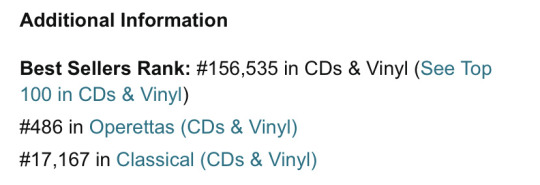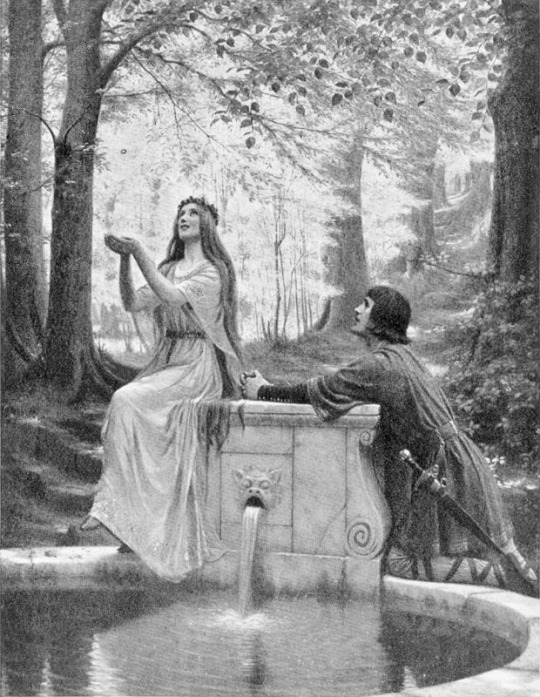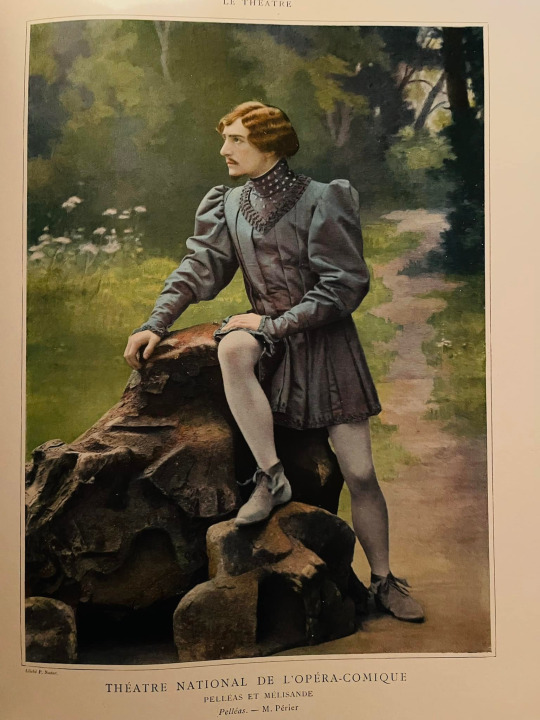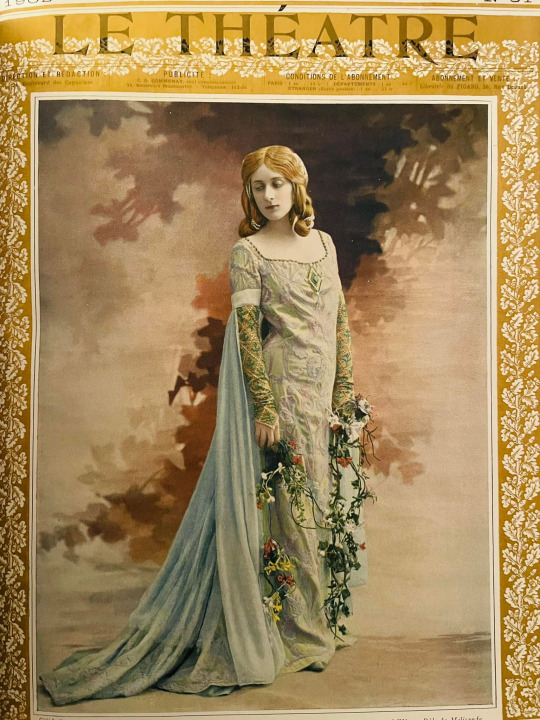#pelléas and mélisande
Text

Sigismund De Ivanowski (1875-1944), ''The Century Magazine'', Vol. 56, #1, May 1908
Miss Mary Garden as Mélisande in Debussy's ''Pelléas and Mélisande''
Source
#Sigismund De Ivanowski#Ukranian artists#the century magazine#claude debussy#Pelléas and Mélisande#vintage illustration#vintage art
94 notes
·
View notes
Text
Ok, I am the only one who became obsessed with Pelléas and Mélisande after listening to this?
For context: "Pelléas and Mélisande (French: Pelléas et Mélisande) is a Symbolist play by the Belgian playwright and author Maurice Maeterlinck. It's about the forbidden, doomed love of the title characters and was first performed in 1893.

The work never achieved great success on stage, apart from operatic setting by Claude Debussy, but was at the time widely read and admired by the symbolist literary elite, such as Strindberg and Rilke. It inspired other contemporary composers, like Gabriel Fauré, Arnold Schoenberg, Jean Sibelius, and Mel Bonis.
Synopsis: Golaud finds Mélisande by a stream in the woods. She has lost her crown in the water but does not wish to retrieve it. They marry, and she instantly wins the favor of Arkël, Golaud's grandfather and king of Allemonde, who is ill. She begins to be drawn to Pelléas, Golaud's brother. They meet by the fountain, where Mélisande loses her wedding ring. Golaud grows suspicious of the lovers, has his son Yniold spy on them, and discovers them caressing, whereupon he kills Pelléas and wounds Mélisande. She later dies after giving birth to an abnormally small girl. Source: Wikipedia.
A very interesting aspect is that it is a Symbolist play adapted numerous time, but especially by Debussy as an opera, that I'm sure Lestat has **convinced** Louis to watch 😄
Also on Wikipedia: "A brief summary of the play will concentrate best on Mélisande. At the beginning of the play she has just escaped from a failed marriage that has so traumatized her that she scarcely remembers either it or her past. She marries Golaud with no choice of her own, and remains essentially distant from him. The audience realize she is falling in love with Pelléas long before she does. On her deathbed she has quite forgotten her final meeting with Pelléas and his death, and dies without realizing that she is dying. This and the whole play—for none of the other characters are wiser—expresses a sense that human beings understand neither themselves nor each other nor the world. The problem is not simply human blindness, but the lack of a fixed and definable reality to be known. This is the Maeterlinck who paved the way for the plays of Samuel Beckett.
A key element in the play is the setting, whether visible in the stage scenery or described in the dialogue. The action takes place in an ancient, decaying castle, surrounded by deep forest, which only occasionally lets sunlight in, and with caverns underneath it that breathe infected air and are in danger of collapse. As numerous critics have pointed out, all this symbolizes the dominating power throughout the action of a destiny fatal to mankind. "
I just love how specific this is, how appropriate and how evocative the whole story is of Louis and Lestat, and I love how Louis does remember it and includes it in his Dreamstat version of it in Paris 🙈

#loustat#amc immortal universe#lestat#lestat x louis#louis de pointe du lac#lestat de lioncourt#come to me#daniel hart#amc iwtv#iwtv#iwtv soundtrack#come to me again#iwtv ost#pelléas and mélisande#Spotify
29 notes
·
View notes
Text

with all due respect (which is none), amazon, pelléas et mélisande is not a fucking operetta
#could you imagine tho. pelléas et mélisande as an operetta.#opera tag#opera#pelléas et mélisande#pelléas and mélisande#debussy#claude debussy#taken from the amazon page for the abbado recording
11 notes
·
View notes
Text

Carlos Schwabe - Pelléas and Mélisande.
21 notes
·
View notes
Quote
We remember the words of Pelléas:
“I played like a child with a thing I did not suspect. . . . I played in my dreams with destiny’s traps.”
Georgette Anderson, Black, Brown, & Beige: Surrealist Writings from Africa and the Diaspora
5 notes
·
View notes
Text

Pelléas et Mélisande by Maurice Maeterlinck
1924
Artist : Carlos Schwabe
572 notes
·
View notes
Text

Costume for Ganna Walska as Mélisande, 'Pelléas et Mélisande', 1931
designed Erté (Romain de Tirtoff) (Russian, active France and United States, 1892-1990)
Silk voile
Center back length: 95 in. (241.3 cm)
Purchased with funds provided by Rita and Ross Barrett, Costume Council Fund, and gift of Anna Bing Arnold (M.87.80.31)
Costume and Textiles
#Ganna Walska#Melisande#Pelleas et Melisande#opera#clothing#fashion#dress#gown#medieval#fantasy#music#Erte#Erté#Pelléas et Mélisande#Mélisande
46 notes
·
View notes
Text

youtube
7 notes
·
View notes
Text


On the occasion of the premiere of the opera
“Pelléas et Mélisande” by Claude Debussy on April 30, 1902 in Paris, this special issue of the magazine “Le Théatre” was published.
Here we see the first two singers of these roles. Jean Périer and MARY GARDEN.
#Pelléas et Mélisande#Claude Debussy#Debussy#composer#classical composer#classical#opera#aria#diva#prima donna#classical music#music history#maestro#chest voice#Jean Périer#baritone#operatic baritone#Mary Garden#Garden#operatic lyric soprano#lyric soprano#operatic soprano#soprano#operatic mezzo soprano#mezzo soprano#opera singer#classical singer#classical singing#classical studies#singing
33 notes
·
View notes
Text
Not counting just refreshing myself on the stuff I was already familiar with (first two books + movie), I've now read two books, two scripts, a graphic novel, and the synopses of no fewer than three operas, AND I've watched an entire goddamn opera, all thanks to the new AMC show.
Also I was going to pick up the next book in the series while I was out today and the only reason I didn't is because it wasn't in stock at the bookstore
#ignore me#every time a piece of media contains significant/intriguing references to an opera#I think to myself ''ooh maybe I'll watch that. that should be an interesting activity to partake in''#forgetting until it's too late that I have NEVER ONCE really enjoyed watching an opera lmfao#anyway yeah I sat through all of Pelléas et Mélisande and it was... fine.#dull and way too long like every opera is but the story was fine I guess#it was fun watching it with Lestat's ''Come to Me'' song in mind though because there definitely ARE parallels to their relationship#(if you kinda squint and look at it through Lestat's victim-tinted glasses lol)#... also YEAH I'm probably gonna read Memnoch soon WHAT OF IT#I can't be stopped I'm riding this vampire train straight into the abyss
1 note
·
View note
Text






you'll fumble each other, like impotent lovers
no pelléas, no mélisande
come to me
INTERIVEW WITH THE VAMPIRE | S02E03
#interview with the vampire#iwtvedit#iwtv amc#iwtv#iwtv spoilers#loustat#louis de pointe du lac#lestat de lioncourt#tvgifs#tvedit#my gifs#louis you are literallyyyy insaaaaane
516 notes
·
View notes
Text

your pelléas, my mélisande
#interview with the vampire#iwtv#lestat de lioncourt#louis de pointe du lac#loustat#my art#mine#digital art#iwtv amc#the vampire chronicles#artists on tumblr#sam reid#jacob anderson
733 notes
·
View notes
Text
i love falling asleep to debussy
#opera tag#opera#pelléas et mélisande#pelléas and mélisande#debussy#claude debussy#10/10 no notes#Spotify
2 notes
·
View notes
Text


Poster for the prèmiere of Claude Debussy and Maurice Maeterlinck's Pelléas and Mélisande at the Théâtre de l'Opéra-Comique, 1902.
5 notes
·
View notes
Text
Is Lestat's relationship to Claudia ever that of an uncle? What other reason might there be for Claudia to call one of the men "Daddy" and the other "Uncle"? Consider the setting.
Why might the filmmakers have chosen to include references to A Doll's House, Madame Bovary, Marriage In A Free Society by Edward Carpenter, and Pelléas et Mélisande? What themes, if any, do these references reinforce?
Claudia calls Louis "the housewife" and Louis later describes himself as "ignoring all other duties of the role Claudia had mocked me for... the unhappy housewife." What does this indicate about attitudes towards gender and sexuality in the society in which the characters live? What is the significance of the word "role" here in relation to Lestat's promise in the first episode to free Louis from "all these roles you conform to"?
When Claudia first introduces the idea of reconceptualizing her relationship to Louis and Lestat as a sister, what does Lestat's reaction suggest about his opinion? In the following episode, when Lestat calls Claudia "sister, daughter, infant death," what is his tone?
In the context of the story, what is a "maker"? What kind of status in the household does Lestat believe a maker should have?
Does becoming vampires allow the characters to escape the social structures of the world around them, or do they remain trapped? In what ways, if any, does sociocultural context in regards to gender, race, sexuality, and family influence the characters and their relationships?
The article "Undoing Feminism: From the Preoedipal to Postfeminism in Anne Rice's Vampire Chronicles" by Janice Doane and Devon Hodges argues that the novel Interview With The Vampire "depends on an oedipal paradigm" and says that "Rice sees the oedipal moment as beginning with the father's embrace of the girl child in a patriarchal order that so restricts her possibilities for development [...] that she develops murderous rages against the father. Freud calls the oedipal stage 'a haven, a refuge' for the girl; Rice shows it to be a coffin." Do you think AMC's Interview With The Vampire is engaging with this idea? Why or why not?
655 notes
·
View notes
Text
i hope daniel hart knows when he wrote the lyrics ruin each other like star-crossed lovers your pelléas my mélisande he physically altered the structure of my brain
#i turn on come to me i listen to come to me 15 times in a row i am always a different person when it's over#writhing on the floor on this totally normal tuesday morning while sam reid purrs in my ear#as you do...#ANYWAY HOW IS EVERYONE BECAUSE I'M FINE#interview with the vampire
63 notes
·
View notes